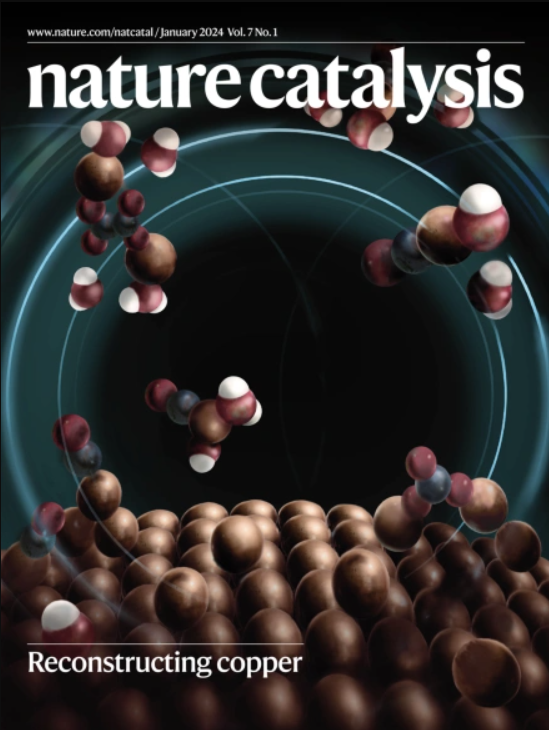氮还原为氨的催化剂
IF 42.8
1区 化学
Q1 CHEMISTRY, PHYSICAL
引用次数: 770
摘要
合成氨的生产仍然依赖于能源和资本密集型的哈伯-博施工艺。分子催化方面的广泛研究表明,二氮可以生产氨,尽管生产率较低。通过对分子催化剂结构的研究,以及对天然存在的氮酶的了解,对二氮还原成氨的机理认识仍在继续。通过坚固的异质催化剂表面过渡到哈伯-博什替代技术仍是一项尚未解决的研究挑战。电化学还原二氮为氨的催化剂是一个特定的研究重点,因为它具有与哈伯-博什工艺竞争并减少相关二氧化碳排放的潜力。然而,由于大多数电催化剂表面缺乏固氮特异性,迄今为止取得的进展有限。在本综述中,我们将讨论该领域在从机理上理解氮酶促进和分子催化剂促进氨合成方面所取得的进展,并对异质电催化剂的技术现状和科学需求进行综述。人工合成氨在开发 100 多年后仍是全球最重要的催化过程之一。本综述讨论了将氮转化为氨的酶催化、均相催化和异相催化方面的最新进展,尤其侧重于如何通过对机理的理解来指导催化剂的设计。本文章由计算机程序翻译,如有差异,请以英文原文为准。

Catalysts for nitrogen reduction to ammonia
The production of synthetic ammonia remains dependent on the energy- and capital-intensive Haber–Bosch process. Extensive research in molecular catalysis has demonstrated ammonia production from dinitrogen, albeit at low production rates. Mechanistic understanding of dinitrogen reduction to ammonia continues to be delineated through study of molecular catalyst structure, as well as through understanding the naturally occurring nitrogenase enzyme. The transition to Haber–Bosch alternatives through robust, heterogeneous catalyst surfaces remains an unsolved research challenge. Catalysts for electrochemical reduction of dinitrogen to ammonia are a specific focus of research, due to the potential to compete with the Haber–Bosch process and reduce associated carbon dioxide emissions. However, limited progress has been made to date, as most electrocatalyst surfaces lack specificity towards nitrogen fixation. In this Review, we discuss the progress of the field in developing a mechanistic understanding of nitrogenase-promoted and molecular catalyst-promoted ammonia synthesis and provide a review of the state of the art and scientific needs for heterogeneous electrocatalysts. The artificial synthesis of ammonia remains one of the most important catalytic processes worldwide, over 100 years after its development. In this Review, recent developments in enzymatic, homogeneous and heterogeneous catalysis towards the conversion of nitrogen to ammonia are discussed, with a particular focus on how mechanistic understanding informs catalyst design.
求助全文
通过发布文献求助,成功后即可免费获取论文全文。
去求助
来源期刊

Nature Catalysis
Chemical Engineering-Bioengineering
CiteScore
52.10
自引率
1.10%
发文量
140
期刊介绍:
Nature Catalysis serves as a platform for researchers across chemistry and related fields, focusing on homogeneous catalysis, heterogeneous catalysis, and biocatalysts, encompassing both fundamental and applied studies. With a particular emphasis on advancing sustainable industries and processes, the journal provides comprehensive coverage of catalysis research, appealing to scientists, engineers, and researchers in academia and industry.
Maintaining the high standards of the Nature brand, Nature Catalysis boasts a dedicated team of professional editors, rigorous peer-review processes, and swift publication times, ensuring editorial independence and quality. The journal publishes work spanning heterogeneous catalysis, homogeneous catalysis, and biocatalysis, covering areas such as catalytic synthesis, mechanisms, characterization, computational studies, nanoparticle catalysis, electrocatalysis, photocatalysis, environmental catalysis, asymmetric catalysis, and various forms of organocatalysis.
 求助内容:
求助内容: 应助结果提醒方式:
应助结果提醒方式:


